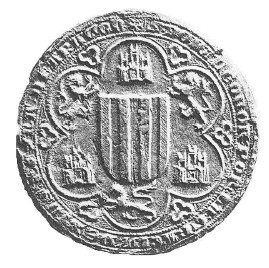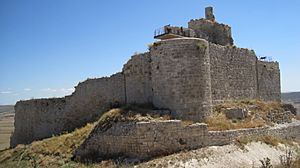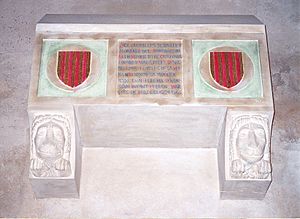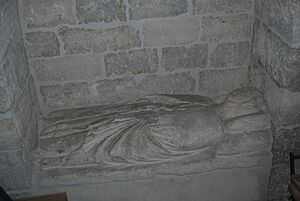Eleanor of Castile (1307–1359) facts for kids
Quick facts for kids Eleanor of Castile |
|
|---|---|

Seal of Queen Eleanor, ca. 1330.
|
|
| Queen consort of Aragon | |
| Tenure | 5 February 1329 – 24 January 1336 |
| Born | 1307 |
| Died | 1359 (aged 51–52) |
| Spouse | Alfonso IV of Aragon |
| Issue | Ferdinand, Marquis of Tortosa John, Lord of Elche |
| House | Castilian House of Ivrea |
| Father | Ferdinand IV of Castile |
| Mother | Constance of Portugal |
| Religion | Roman Catholicism |
Eleanor of Castile (born 1307, died 1359) was a queen of Aragon. She was the wife of King Alfonso IV from 1329 to 1336.
Contents
Becoming a Queen
Eleanor was the oldest daughter of King Ferdinand IV of Castile and his wife, Constance of Portugal. When she was just four years old, Eleanor was promised in marriage to James. He was the oldest son and future king of James II of Aragon. This agreement was made in 1311.
Eleanor was sent to the Aragonese court to be raised there. She would learn how to be a queen. When she was five, her father, King Ferdinand IV, died. A year later, her mother, Queen Constance, also passed away. Eleanor's grandmother, Maria de Molina, then ruled Castile for Eleanor's younger brother, King Alfonso XI of Castile.
Young James, Eleanor's fiancé, really wanted to become a monk. He did not want to marry. Even the Pope, Pope John XXII, told James he had a duty to marry. James II and his son had a difficult relationship. Before the wedding in October 1319, James promised to marry Eleanor. But he only agreed to be at the wedding ceremony. He did not want to actually be married to her.
A Broken Engagement
On October 18, 1319, the wedding ceremony between James of Aragon and Eleanor of Castile took place. But James refused to give the traditional "kiss of peace" during the ceremony. His father, King James II, had to do it instead. After the ceremony, James told his father again that he wanted to give up his right to the throne. He wanted to join a monastery.
After arguing with his father, James ran away on horseback. He left Eleanor behind. In December 1319, he officially gave up his claim to the throne of Aragon. He then became a Knight Hospitaller, which was a religious military order.
Alfonso, King James II's younger son, then became the next in line to the throne. James's rejection of Eleanor could have caused big problems between Castile and Aragon. King James II told Eleanor's grandmother how sorry he was for his son's actions. Eleanor stayed in Tortosa for a while. During this time, James II and Alfonso found out that James was planning to get Eleanor back and reclaim his throne. But his father stopped this plan.
After Tortosa, Eleanor lived in other cities. Later, some Castilian nobles took her back to Castile. Once home, Eleanor went to the Abbey of Santa María la Real de Las Huelgas. She did not become a nun, though. In 1325, King Edward II of England suggested that his son, Edward, marry Eleanor. But this marriage never happened because Edward II was removed from power.
Becoming Queen of Aragon
In January 1329, Eleanor became engaged to King Alfonso IV of Aragon. Their wedding took place a month later, on February 5, in Tarazona. King Alfonso XI of Castile and other important people attended the ceremony. King Alfonso IV gave Eleanor the city of Huesca and other lands. This marriage helped improve relations between Castile and Aragon. It also helped them form a new alliance to fight against the Moors in Granada. This marriage ended a pattern where Aragon had broken several marriage agreements with Castile.
Eleanor became a strong influence in Aragon. She tried to get more power and land for her own sons, Ferdinand and John. They were younger than her stepson, Peter. Peter was the son of Alfonso IV's first wife, Teresa d'Entença. Eleanor convinced her husband to give large amounts of land to her sons.
King Alfonso IV was very generous. On December 28, 1329, he gave Ferdinand the Marquisate of Tortosa and many cities like Albarracín, Orihuela, and Alicante. Eleanor's younger son, John, also received several lordships, including Elche.
These gifts from Alfonso IV reduced the lands belonging to the crown. This made Peter, the heir, and his supporters very unhappy. The nobles in Aragon became divided. One group supported Queen Eleanor and her sons. The other group supported Peter and his rights. When the King gave Ferdinand even more cities in the Kingdom of Valencia, the local people protested. Because of this, the King decided to take back these last gifts.
A Difficult Widowhood
After King Alfonso IV died on January 24, 1336, Queen Eleanor fled to Castile. She took her two sons, Ferdinand and John, with her. She was afraid of the new king, Peter IV of Aragon. Peter was angry with his stepmother and stepbrothers. He felt they had been favored over him.
In his will, written in 1333, Alfonso IV left Eleanor all her jewels. He also confirmed that she owned the cities he had given her when they married. He left their oldest son, Ferdinand, the Marquisates of Tortosa and Albarracín. When Eleanor escaped to Castile, she took a lot of gold, silver, and jewels. King Peter IV tried to stop her and her sons from leaving Aragon. At first, the new king tried to take away Eleanor's income. But in 1338, he let her and her sons keep their lands. He did not want to anger Castile, especially when the whole Iberian Peninsula was facing a new Moorish invasion.
Once in Castile, Eleanor continued to cause problems. This time, it was against her nephew, King Peter I. Her youngest son, John of Aragon, was killed in Bilbao in 1358. This was ordered by his cousin, the Castilian king. A year later, in 1359, Eleanor herself was murdered in the castle of Castrojeriz. This was also ordered by her nephew. Four years later, in 1363, her oldest son, Ferdinand of Aragon, was killed. This was ordered by his half-brother, King Peter IV.
Where is Eleanor Buried?
There is some debate about where Queen Eleanor of Castile was finally buried. Three places claim to have her remains:
- the Old Cathedral of Lleida
- the Church of Nuestra Señora del Manzano in Castrojeriz
- the Abbey of Santa María la Real de Las Huelgas, where many Castilian royals are buried.
At the Abbey of Santa María la Real de Las Huelgas, there was a white marble tomb. It was said to hold Queen Eleanor's remains. However, the name carved on the tomb was María of Almenara. Inside this tomb, five skulls and bones were found. It is thought that Queen Eleanor might have been buried in María of Almenara's tomb. María's remains might have been moved to another tomb nearby. This other tomb contained a female mummy. The tomb believed to be Eleanor's was cut to fit. On one side, the dead woman is shown on her deathbed. Two angels carry her soul to heaven. On the sides, there are bishops and other figures. Below, dogs chase harpies and dragons bite. On the other side of the tomb, there are plant designs and an epitaph.
In the Old Cathedral of Lleida, there is a tomb. On October 23, 1986, the remains of Alfonso IV of Aragon were placed there. Next to him, the remains of a young man were also placed. He was identified as Prince Ferdinand, Alfonso IV's son. The remains of an adult woman were also placed there. She was identified as Queen Eleanor, Alfonso IV's second wife. Alfonso IV's remains had been moved to the Old Cathedral of Lleida in 1781. They stayed in the crypt until 1986. Then, they were placed in a stone tomb near the San Berenguer door of the cathedral.
In the Church of Nuestra Señora del Manzano in Castrojeriz, another tomb is kept. It is believed to belong to Queen Eleanor of Castile. It is located at the front of the church, near the baptistery. It was found in June 1970, hidden behind a wall. Experts believed it belonged to Eleanor, daughter of Ferdinand IV. This is because the tomb's style matches other tombs from the mid-14th century. Also, the top of the tomb has the sculpted figure of a woman. Some documents also support the idea that Queen Eleanor was buried in this tomb.
Images for kids
See also
 In Spanish: Leonor de Castilla (1307-1359) para niños
In Spanish: Leonor de Castilla (1307-1359) para niños








